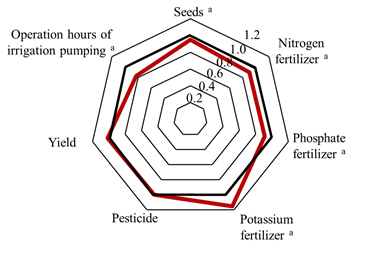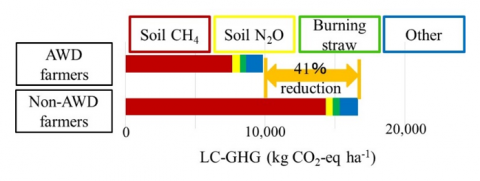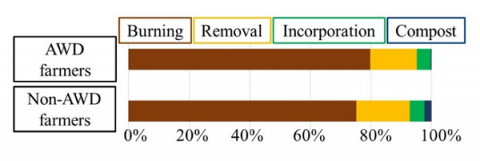Potential mitigation of life cycle greenhouse gas emissions from rice cultivation by alternate wetting and drying (AWD)
Description
Alternate wetting and drying (AWD) has been introduced in Vietnam’s Mekong delta to reduce soil methane (CH4) emissions from rice (Oryza sativa L.) cultivation, to mitigate climate change, and to save water consumption. The benefits of AWD (e.g., reducing irrigation cost and increasing yields) have been reported by many researchers, including researchers in Japan International Research Center for Agricultural Sciences and Can Tho University. However, there is less information about the trade-off among soil CH4 emissions reduction, nitrous oxide (N2O) emissions, and agronomic management. The present study carried out a life cycle assessment to evaluate the impacts of AWD on potential mitigation of life-cycle greenhouse gas (LC-GHG) emissions.A structured interview was carried out in An Giang Province, Vietnam, which is the 5th-largest rice producer in the world. In August and September 2019, 200 farmers were interviewed: 100 farmers with 199 fields and 100 non-AWD farmers with 187 fields. Vietnamese staff members of Can Tho University conducted the interviews. The system boundary and functional unit for the LCA were defined as a cradle-to-farm gate and 1 ha of paddy rice, respectively. The soil and non-soil CH4 and N2O emissions for the AWD and non-AWD farmers were estimated with reference to the IPCC tier 1 methodology (2019). The present study showed that AWD farmers lowered the use of seeds, nitrogen, phosphate fertilizers, and operation hours of irrigation pumps without decreasing rice yields. Despite an increase in N2O emissions by 17% due to wet (anaerobic) - dry (aerobic) cycles by AWD which enhances nitrification-denitrification processes, and application rates of potassium, LC-GHG emissions were reduced by 41%, lowering soil CH4 emissions by 47% and non-soil GHG emissions (burning straw and other managements) by 9%. LC-GHG emissions from AWD farmers and non-AWD farmers were estimated to be 9.82 and 16.6 t CO2-eq ha–1, respectively. Unlike water management, straw management had little influence on the CH4 emissions difference between groups, as >75% of farmers irrespective of the water management carried out on-site burning as straw management. To the best of the authors’ knowledge, the present study is one of the first studies to survey rice straw management under different water management strategies.
These results can be utilized as scientific evidence for policy making and implementation. In addition, they can be used to estimate potential mitigation of LC-GHG emissions for a country where AWD is introduced. Moreover, the methodology used in the present study can be applied for the other countries.
Figure, table
-
Fig. 1. Ratios of AWD farmers to non-AWD farmers in the use of seeds, nitrogen, phosphate, potassium fertilizers, pesticide, yield, and operation hours of irrigation pumping
The red line in the chart shows the ratio of AWD farmers to non-AWD farmers. If the ratio is greater than 1, the value of the corresponding item for AWD farmers is greater than that of non-AWD farmers (a: Significantly different at p<0.05).
-
Fig. 2. Comparing GHG emissions between AWD farmers and non-AWD farmers
-
Fig. 3. Rice straw management between AWD farmers and non-AWD farmers
- Affiliation
-
Japan International Research Center for Agricultural Sciences Social Sciences Division
- Classification
-
Research
- Research project
- Program name
- Term of research
-
FY2020(FY2019~FY2020)
- Responsible researcher
-
Leon Ai ( Social Sciences Division )
ORCID ID0000-0002-8367-4873KAKEN Researcher No.: 70751387Minamikawa Kazunori ( Crop, Livestock and Environment Division )
Izumi Taro ( Rural Development Division )
Nguyen Huu Chiem ( Can Tho University )
- ほか
- Publication, etc.
-
https://doi.org/10.1016/j.jclepro.2020.125309
Leon A et al. (2020) Journal of Cleaner Production, 285:125309
- Japanese PDF
-
2020_A02_A4_ja.pdf398.49 KB
2020_A02_A3_ja.pdf397.96 KB
- English PDF
-
2020_A02_A4_en.pdf458.45 KB
2020_A02_A3_en.pdf458.15 KB
- Poster PDF
-
2020_A02_poster.pdf492.61 KB
* Affiliation at the time of implementation of the study.



